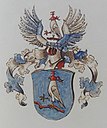List of coats of arms in Bad Salzuflen
The list of coats of arms in Bad Salzuflen shows the coats of arms of the Lippe city of Bad Salzuflen in North Rhine-Westphalia , Germany , which merged former cities and communities and people living in the urban area as part of the implementation of the "Law for the reorganization of the district of Lemgo" to form the new city of Bad Salzuflen Familys.
Bad Salzuflen
Bad Salzuflen
The Bad Salzuflen city coat of arms shows in blue a hexagonal red well shaft with two silver (white) gallows trees, on which a rising, behind a sinking golden (yellow) bucket hangs, above a golden (yellow) eight-pointed star. It was last approved on March 31, 1970 by the district president in Detmold. The coat of arms, documented since the 16th century, goes back to a seal from 1375. The fountain indicates the salt springs and the star indicates that it was part of the Sternberg county .
Former city with its own coat of arms
Schötmar
The coat of arms shows a black gear in green, accompanied by a silver wave bar at the top and bottom. The coat of arms was awarded to the city on April 1, 1921 by the Lippe state government. The color green stands for field and forest, the cog wheel for industrial development, the two wavy bars for the Bega and Werre rivers.
Former municipalities with their own coat of arms
Municipality of Retzen
In gold (yellow) a raised blue oblique left bar covered with three golden (yellow) reeds. The coat of arms was awarded to the community on July 16, 1963 by the Minister of the Interior of North Rhine-Westphalia. It refers to Rethar (reed, reed) a possible derivation of Retzen. The reeds stand for the place name.
Municipality of Wüsten
The coat of arms shows in blue over a silver shield base covered with the red Lippe rose , a golden-rooted oak stump that bears new leaves and fruit. The coat of arms designed by Kurt Herold was awarded to the community on June 26, 1961 by the Minister of the Interior of North Rhine-Westphalia. It symbolizes the emergence of a new Lippe settlement (Lippische Rose) from a deforested forest area.
Family coat of arms
Aristocratic family Ribbentrop
1823: square with heart shield ; a silver lamb in blue on the green ground. 1 and 4 in blue on a green ground an armored archer turned to the right, 2 and 3 six gold arrows turned to the right one above the other, covered by a golden quiver placed obliquely to the left. On the crowned helmet with blue and silver blankets on the right and red and gold on the left, a natural crane with a gold stone in the raised right hand.
1826: A silver lamb in gold on green ground. On the crowned helmet with green and gold covers the crane (as above).
1884: Divided: Above in red a silver lamb walking on the dividing line, below in silver two upward-pointing black cannon barrels. On the helmet with red and silver covers on the right and black and silver covers on the left (as above).
Noble family Stietencron
A silver pole in blue, which is accompanied on the right by an inward-facing, golden crescent moon with a face and on the left by three six-pointed golden stars standing one below the other.
Noble family von Lengerke
Hetland
Coat of arms of the Hetland family in deserts
Individual proof
- ↑ a b J. A. / Konrad Tyroff (ed.), Book of Arms of the Prussian Monarchy , Volume IV, Nuremberg 1846, Plate 33







